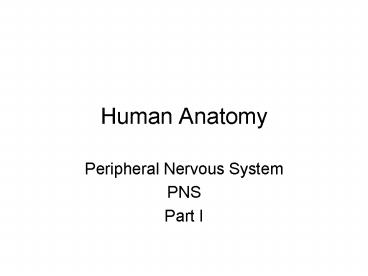Human Anatomy - PowerPoint PPT Presentation
1 / 46
Title:
Human Anatomy
Description:
Human Anatomy Peripheral Nervous System PNS Part I 2 Components of PNS 12 pr. of cranial nerves 31 pr. of spinal nerves So .what is a nerve? Structure of a Nerve ... – PowerPoint PPT presentation
Number of Views:51
Avg rating:3.0/5.0
Title: Human Anatomy
1
Human Anatomy
- Peripheral Nervous System
- PNS
- Part I
2
2 Components of PNS
- 12 pr. of cranial nerves
- 31 pr. of spinal nerves
- So.what is a nerve?
3
Structure of a Nerve
4
Structure of a Nerve
- Connective tissue organized similar to muscle
- Epineurium surrounds the entire nerve
5
Structure of a Nerve
- 2. perineurium surrounds a fascicle
Fascicle a bundle of axons
fascicle
perineurium
6
Structure of a Nerve
Fascicle
Perineurium
7
Structure of a Nerve
- 3. Endoneurium surrounds each axon
8
Types of Nerves
- Sensory all axons in all fascicles going from
periphery to spinal cord - Motor all axons in all fascicles going from
spinal cord to skeletal muscle (or other organs) - Mixed axons within the nerve going in different
directions BUT not within the same fascicles. - All axons within a single fascicle are going in
only one direction
9
Structure of a Nerve
Axons
10
Cranial Nerves (12)
11
Cranial Nerves
- Found on inferior surface of brain
12
Cranial Nerves
- Some are sensory n.
- Periphery (skin or other organs) to brain
- Some are motor n.
- Brain to periphery (muscle or another organ)
- Some are mixed n.
- Both directions
- All 12 pr. can be used to test various areas of
the brain - For instance.
13
The Optic Nerve
A patient comes in with a vision problem
14
Study Hint for the Cranial Nerves
- Make a table with 6 columns
- The headings for the 6 columns (L to R) should
be - Number
- Name
- S, M, or B (B mixed)
- Function
- Test
- Special features
15
(No Transcript)
16
I Olfactory
- Sensory
- Olfaction
- Bulb
17
I Olfactory
18
I Olfactory
Olfactory bulb Cribriform plate
19
Location of Olfactory Bulb
Cribriform plates
20
II Optic
- Sensory
- Vision
- Comprised of axons from rods and cones of retina
21
II Optic
22
Extrinsic Eye Muscle
- Six muscles that attach to eyeball and are
responsible for moving (gazing) the eye within
the orbit.
23
Extrinsic Eye Muscles
- Names
- Superior rectus
- Inferior rectus
- Lateral rectus
- Medial rectus
- Superior oblique
- Inferior oblique
24
III, IV and VI
- Cranial n. III, IV and VI innervate the 6
extrinsic eye muscles - All 3 nerves are pure motor nerves
- III oculomotor
- IV trochlear
- VI -- abducens
25
Extrinsic Eye Muscles
- Which nerve innervates which muscle(s)?
- LR6SO4
- Superior rectus III
- Inferior rectus III
- Lateral rectus VI
- Medial rectus III
- Superior oblique IV
- Inferior oblique III
26
V Trigeminal
- Three divisions (branches) of V V1, V2 and V3
27
V Trigeminal
- V1 ophthalmic branch, purely sensory
28
V Trigeminal
- V2 maxillary branch, purely sensory
29
V Trigeminal
- V3 mandibular branch, both motor and sensory
a mixed nerve branch - Therefore, because V3 is a mixed nerve, the
trigeminal nerve has to be considered a mixed
cranial nerve.
30
V3 Trigeminal
- Motor to muscles of mastication (chewing)
sensory
31
Tic Douloureux
- Sudden discharge of V2 and V3
- Causes intense pain to areas innervated by V2 and
V3 - Trigeminal neuralgia
- 1/25,000 and usually 40 yo and older
32
VII Facial
33
VII Facial
- Mixed
- Motor to facial muscles (5 branches)
- Sensory from taste buds anterior 2/3 of the
tongue - Exits through stylomastoid foramen
- Bells Palsey -- dysfunction of VII because of
viral inflammation - Results in facial muscle paralysis on one side
- Usually cures itself within weeks or a few
months
34
VII Facial
35
VIII Vestibulocochlear
- Semicircular canals balance abd equilibrium
- Cochlea
- hearing
36
VIII Vestibulocochlear
- Sensory
- Hearing and balance
- Cochlea and semicircular canals
37
IX Glossopharyngeal
38
IX Glossopharyngeal
- Mixed
- Motor to
- Swallowing muscles of pharynx
- Parotid salivary gland (saliva producing)
- Sensory from
- Taste from posterior 1/3 of tongue
- Lining of pharynx
- Soft palate
39
X Vagus
- Longest cranial n. in
- human body
- Innervates head, neck,
- thorax and abdomen
40
X Vagus
- Mixed
- Motor to
- Pharyngeal and laryngeal muscles
- Organs in thorax and abdomen
- Lungs and heart
- Liver, stomach, intestines
41
X Vagus
42
X Vagus
- Mixed
- Sensory from
- Pharynx
- External auditory canal
- Organs of thorax and abdomen
43
X Vagus
Vagotomy to inhibit gastric acid secretion
44
XI Accessory
45
XI Accessory
- Motor
- Motor to
- Sternocleidomastoid
- Trapezius
- Pharyngeal and laryngeal muscles
46
XII Hypoglossal
- Motor to muscles of the tongue
- Tongue points to side of lesion



























![[PDF] Netter's Anatomy Coloring Book (Netter Basic Science) Kindle PowerPoint PPT Presentation](https://s3.amazonaws.com/images.powershow.com/10082431.th0.jpg?_=20240720108)



